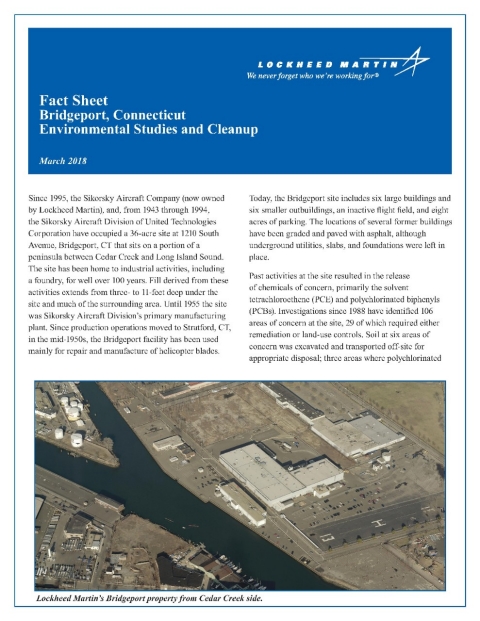History
Today, the Bridgeport site includes six large buildings and six smaller outbuildings, an inactive flight field, and eight acres of parking. The locations of several former buildings have been graded and paved with asphalt, although underground utilities, slabs and foundations were left in place.
- The site has been home to various industrial activities, including a foundry, for well over 100 years. Fill derived from these activities extends from three- to 11- feet deep under the site and much of the surrounding area.
- The site was the primary manufacturing plant for Sikorsky Aircraft Division of United Aircraft Corporation (now United Technologies Corporation) from 1943 until 1955, when production moved to Stratford, CT. Since then, the Bridgeport site has been used mainly for repair and manufacture of helicopter blades.
Contamination
Past activities at the site resulted in the release primarily of the solvent tetrachloroethene (PCE) and polychlorinated biphenyls (PCBs).Since 1988 106 areas of concern have been identified at the site, 29 of which required either remediation or introduction of land-use controls.
- Soil at six areas of concern was excavated and transported off-site for appropriate disposal; three areas where polychlorinated biphenyls (PCBs) were detected above 10 ppm were either excavated, or consolidated and capped in place. Lockheed Martin plans to voluntarily remove the remaining consolidated PCB-impacted soil where the PCB concentration exceeds 10 ppm in 2018.
- Fill covering the site contained several contamination hot spots. The affected soil was excavated and disposed of at a licensed landfill. The pavement in several areas was upgraded to provide a more secure cap, and landscaping covers other areas.
- Soil vapor in three areas beneath the main manufacturing buildings exceeded criteria for several volatile organic compounds; these were reduced using vapor extraction systems.
- A plume contaminated with a solvent that most likely came from a leaking tank (the tank was removed), was found in groundwater perched atop the layer of silt and clay that underlies a portion of the Bridgeport site. While the levels of the contaminant are below surface water protection standards, and the Connecticut Department of Energy and Environmental Protection (CT DEEP) notes no further action is required for this plume, Lockheed Martin is voluntarily investigating ways to further remediate the condition.
Groundwater and soil vapor at the site is monitored on a 15-month schedule and results are provided to the Connecticut DEEP.
Community Information
If you have questions, please contact Lockheed Martin Communications.
lm.communications@lmco.com
800.449.4486
View a List of Terms Commonly Used in Relation to General Environmental Remediation Efforts




